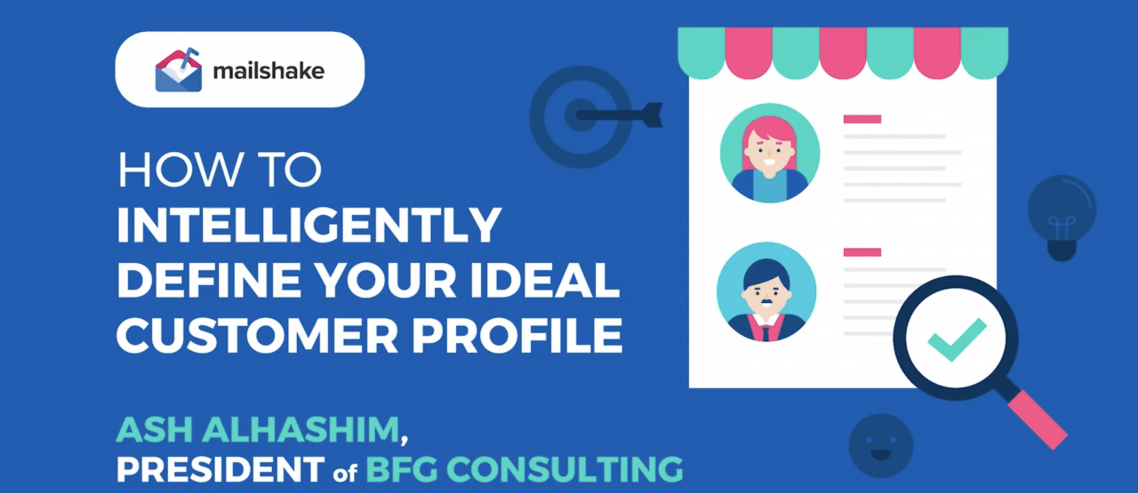How to Intelligently Define Your Ideal Customer Profile

Contents
The concept of an ideal customer profile (ICP) has a lot of noise around it right now. From the varying definitions of what an ICP really is to mixing ICP up with persona profiling, a lot of brands are getting it wrong – and this can have a dramatic impact on their bottom line.
I recently sat down with Ash Alhashim, President of BFG Consulting, to pick his brain on what goes into an ICP, the risks of getting it wrong, and the rewards of getting it right.
Ash has been in sales for 13 years and spent the last seven in sales leadership roles for companies including Optimizely and Sift. Recently, he’s been focusing on helping B2B tech startups get up and running by building and scaling their go to market teams.
In other words, there are few better people to ask when it comes to the subject of ICPs.
Watch the interview below, or read on for the highlights.
Why Identify an ICP? [2:10]
“Critical is an understatement” when it comes to the importance of defining an ICP, says Ash. They’re really all about being “customer-obsessed.”
He underlines that over the past decade, B2C companies – especially web-first companies – have figured out that they need to be customer-obsessed. In the B2C world, everything revolves around the customer.
Yet B2B companies are just starting to figure that out.
To stay ahead in sales now, he notes, it’s all about moving towards a flywheel model for thinking about how you acquire, grow, and retain your customer base.
“The most customer-obsessed companies are really winning, the market showing that time and time again in recent years.”
How Does Having an ICP Boost Business? [03:38]
According to Ash, from an operational perspective, ICP serves as your company’s north star.
He notes that everyone in your organization must be ICP-aligned, so you’re all working effectively and efficiently together.
This makes total sense: you can’t be customer-obsessed without knowing and having a clear vision of who the customer is, right?
Indeed, over the last 6-9 months, I’ve made a huge effort to ensure everyone at Mailshake is ICP-aligned.
This process started out with the sales team defining it and has progressed to the point that now we get ICP-related product feedback from the dev team. Everybody’s in alignment as far as knowing exactly who we’re selling to.
What Is an ICP? [04.43]
In the most basic sense, ICP stands for Ideal Customer Profile – it’s about who you want and need to be selling to.
But hang on a second, isn’t that what personas are for?
In a word, yes. But your ICP should work alongside your personas to boost sales. The secret to a strong ICP is in restraining yourself when it comes to details.
The technical definition of an ICP is a company-level definition, Ash underlines. “It is not persona-specific or case-specific, or the messaging and sequence you’ll use to acquire companies in that space as customers.”
“Those things matter a lot, and an ICP is kind of worthless without those details, but those are the next steps. This is the 101 level course: defining the ICP at a company level, and then you have to build on that.”
What Demographic Information Makes Up an ICP? [5:50]
So what should you include?
“What I’m talking about is a qualitative and quantitative understanding of who your customers are at a company level,” Ash explains.
He recommends primarily looking at demographic attributes like:
- Location
- Company size – by revenue or number of employees
- Technological maturity levels
Ash explains that these elements are often the first things he looks at when it comes to ICPs because they’re relatively easy to deduce and highly effective at mapping out what your ideal customer profile should look like.
He also identifies some more sophisticated ways to take your ICP definitions to the next level. He recommends using the social graph and building predictive models.
It works like this:
“If you and I both know these same 10 people, then we’re likely to know these other 10 people as well, depending on our friend groups and connections. The same works with technology, and some companies – like DemandBase for example – use AI to help their clients figure out their ICPs depending on who they’ve already sold to specifically.”
Using Tools to Build Your ICP [6:33]
There are loads of useful tools out there that can assist with ICP creation.
Ash recommends BuiltWith, which he thinks does a great job of figuring out what technologies are installed on businesses’ websites.
He explains that this allows you to determine, for example, that “these companies have some of the most cutting-edge technologies installed on their websites, and therefore their level of technological maturity or savviness is higher. And this means they’re more likely or less likely to buy our product depending on what we’re offering.”
What Can Behavioral Attributes Tell Us? [08:00]
Ash highlights that in addition to the demographic attributes, you can also use behavioral attributes or intent attributes to define your ICP.
These can include:
- How many times a prospect has visited your website in the last month
- Which conferences or events people or companies are attending or sponsoring
- Whether or not a company has entered into a sales cycle with a competitor
- Whether or not a company has churned off of a competitor
“These are all strong behavior attributes that you can also use to define a list of ideal customers to go after,” he says.
When do you need to start defining your ICP? [08:38]
As early as possible.
According to Ash, “If you haven’t done it yet and you are making money, it’s already late”.
Why?
“ICP is an exercise in focus. Ruthless focus. There’s the proverb that the dog that chases two rabbits catches none.”
It’s vital to remember that your ICP will never be perfect, so don’t let an initial lack of data deter you from defining your ICP.
Ash explains: “For early-stage companies that maybe don’t have many customers or have only a few customers, it is hard to build a ‘lookalike model’ for ICP because you don’t really know what you should be going after.
“This is where a lot of hypothesis forming and human interpretation has to happen, and you make your best guess.”
Use Your Competitors’ Clients [10:27]
Ash recommends using competitors’ clients for market research.
This can help you understand:
- What the use case is
- Who the people who are buying are
- Satisfaction levels
- Problems with the products
- What they’re trying to accomplish day-to-day
Then consider: “how can we serve them better when we get there?”
Ash says: “After hundreds of these conversations, you start to figure out some patterns.
“And then as a team, you synthesize the data, you scrub it, you brainstorm, you figure out ‘alright, what is our product actually gonna be?’, or ‘what are we gonna prioritize in our product roadmap in the coming year in order to effectively serve this segment of the market?’, because this is the ICP we want to target at first.”
Define and Redefine [11:40]
Early on, businesses should frequently define and redefine their ICP. This is when you’re learning and things are often changing rapidly.
Later, as you become more confident in your knowledge of your sector, reduce this frequency down to roughly once a year.
“One of the bigger misconceptions with regard to defining ICP and being focused is that if you get it wrong you’re somehow in trouble,” Ash says.
“I would say the vast majority of times, the reasons companies struggle to acquire customers isn’t because they’ve defined the wrong ICP, it’s because they don’t know where they’re going.”
“Just do it, take that leap of faith, it’ll pay off, I promise. And again, you’ll refine it and tweak it over time.”
Effective ICPs Have a “Persona Taxonomy” [14:24]
ICP on its own is just a tiered target list – it’s not super prescriptive.
Ash explains that in order for ICP to be prescriptive, you need persona taxonomy.
He suggests businesses use case ideas such as:
- The current way of doing things
- The problem with that use case
- What limitations does it have?
Then layer in the need: the “this is how we help.”
Ash says: “The companies I’ve seen do this best really take it seriously. And one company in particular I’ve worked with, they actually have their five personas like superhero cutouts all over the office.”
The Golden Formula [16:30]
The spirit of the ICP should be alive and well in the organization, Ash emphasizes. This will make it useful from a day-to-day perspective for your sales reps and your marketing teams.
Ash notes that he’s seen a lot of companies “flail and struggle” to input all the information into their CRM and make it perfect – but it doesn’t have to be.
Instead, he recommends simply using a Google sheet and inputting:
-
- Industry
- Operating model
- Company/customer names
- Case study links or blurbs on their story
For me, that spreadsheet format is perfect. I guarantee if you give that to your sales team, they’re done – they don’t need to ask any more questions.
A final thought from Ash: “Let’s not let the impossible perfect become the enemy of the possible good.”
Now go figure out and define your ICP.
Are you happy with your ICP? How often do you redefine it? Sound off in the comments. For further info, check out Ash’s website BFG Consulting.





